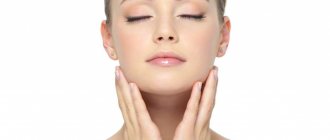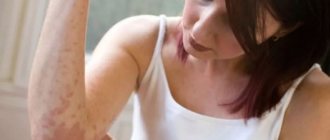- Signs of the disease
- Depriving forms
- Causes
- Initial stage of the disease
- Period of rash
- Crust formation
- Diagnostics
- How to treat an infection?
- What are antiviral drugs used for?
- Possible consequences
- Is shingles contagious?
- When is shingles transmitted?
- Disease prevention
- Which doctor should I consult with this disease?
Shingles has vivid and painful symptoms. Most often, the disease is detected in older people. An unfavorable environment contributes to the development of infection in young people with weak immunity. Shingles often develops against the background of cancer, especially in people with weakened immune systems (after chemotherapy, for example).
Depriving forms
The disease can be typical or atypical.
In the atypical form, symptoms may be mild:
- In the abortive form, the rash is absent or there is a single focus;
- Bullous form - multiple blisters with clear liquid;
- Hemorrhagic form - blisters with bloody fluid, in place of which scars remain.
- The gangrenous form leaves difficult-to-heal ulcers and rough scars.
Prohibited for shingles
Not used to treat rashes:
- clotrimazole and other antifungal drugs;
- oxolinic ointment;
- ointments with hormonal components - Triderm, Hydrocortisone, Akriderm, etc.
If you have shingles, you should not:
- warm the affected areas of the skin;
- open bubbles;
- treat rashes with alcohol;
- use various folk remedies.
Also:
- you cannot go to the bathhouse or sauna;
- do not take a hot bath;
- Do not rub the skin with a rough brush.
Period of rash
The type of rash depends on the severity of the disease. At the initial stage, the rashes look like small pink spots located on healthy skin.
If the process develops typically, then the next day they are replaced by bubbles with a clear liquid - grouped vesicles. After 3 days, their contents become cloudy. The rash occurs in spurts, with breaks of several days.
If a severe gangrenous form develops, the filling of the vesicles may be mixed with blood. It seems that the bubbles move to another place, located around the body.
If the form of inflammation is mild, the manifestation of the disease can only be neurological in nature, when the patient feels pain, but there is no rash. This is herpetic neuralgia.
Herpes zoster (shingles) - symptoms and treatment
There is no incubation period in the usual sense, since herpes zoster is not a primary infection. A whole life can pass, and the manifestation will still occur, although the virus is present in the body.
It is difficult to predict the development of the disease. Its onset and manifestations vary widely and depend on the severity. The disease may be preceded by stress, trauma or acute respiratory infections.
The symptoms of individual forms of herpes zoster are distinguished.
Gangliocutaneous form
This form begins with a prodrome - mild malaise, sensory disturbances, moderate pain in the areas of future rashes. This period lasts up to seven days. Then the pain becomes severe, fever appears, and a moderately severe syndrome of general infectious intoxication appears. Sometimes the pain intensifies even when the wind blows (so-called allodynic pain - from non-painful stimuli).
After 3-10 days, a vesicular rash appears in these places against a background of redness. In this case, the intensity of pain usually decreases. The rash occurs on one side, limited to the area of innervation of one sensory ganglion. Vesicles tend to cluster.
Subsequently, the contents of the vesicles become cloudy and sometimes burst open. After 4-5 days from the appearance of the rash, crusts appear. They disappear after 2-4 weeks of illness.
Rashes are allowed without a trace, but only in the absence of scratching and deep inflammatory damage. But pain phenomena can persist for a long time, sometimes up to a year. This requires timely antiviral therapy and pain relief.
In general, the pain with herpes zoster is quite pronounced and intensifies with movement or touch (even a slight one). They can be classified as acute (from prodrome to one month), subacute (1-4 months) and chronic (more than 4 months - postherpetic neuralgia - typical neuropathic pain). The nature of the pain can be different - constant and spontaneous, often burning, pressing. Sometimes the pain is compared to an electric shock. They can cause significant physical suffering to patients, disrupt sleep, and exhaust the patient.
The localization of pain and rash corresponds to the projection of the affected nerves.
Eye shape
Rashes appear on the face, nose and eyes. This is due to damage to the trigeminal nerve and gasserian ganglion. The rash spreads from the level of the eye to the parietal region, abruptly stopping along the midline of the forehead. Sometimes the process affects the eye.
Ear shape
The geniculate node is affected. In this case, the auricle and external auditory canal are captured. Paralysis of the facial nerve and facial muscles may occur - the so-called. Hunt's syndrome. Taste sensitivity is lost.
Gangrenous (necrotic) form
Deep skin damage occurs. Rough scars form, sometimes with hemorrhagic impregnation of the contents - hemorrhagic form. Most often it develops in older people with a complicated somatic history - diabetes mellitus, peptic ulcer, etc.
Meningoencephalitic form
It is more often observed when the rash is located on the head. The temperature rises, headaches, nausea and vomiting occur, which does not bring relief, meningeal syndrome, impaired consciousness, coma. The mortality rate for this condition is over 60%.
Disseminated form
Occurs with AIDS. The rash spreads throughout the entire skin. Often this affects internal organs - lungs, brain, liver, kidneys. The prognosis is unfavorable.
Ganglioneuralgic form
There are no characteristic rashes, but there is obvious pain. Diagnosis is extremely difficult. Due to the very late diagnosis, treatment is limited to pain relief only. The use of antiviral drugs in the delayed period clearly does not affect the process.
Herpes zoster during pregnancy
In pregnant women, herpes zoster (in the absence of HIV) usually does not have any differences. It does not affect the course of pregnancy and does not cause damage to the fetus/child[2][3][6][8][10].
What are antiviral drugs used for?
The goal is to exclude the development of complications. Antiherpetic treatment helps the ulcers heal quickly and improves the patient's condition.
The course of treatment and dosage of medications is determined by the doctor taking into account the general condition of the patient. On average, treatment time does not exceed 10 days.
If a gangrenous form with a bacterial infection develops, antibiotics, immunomodulators, physiotherapeutic procedures and vitamins are prescribed.
When it comes to treating rashes, there are different opinions regarding the use of drying agents. In any case, they should be used with caution so as not to worsen the condition of the skin by burning.
Hormonal medications should not be used as they suppress the immune system.
Treatment of the disease in elderly patients is not always successful, since antiviral drugs are not justified.
Causes of the disease
For most people, the herpes zoster virus first enters the body in childhood or adolescence. Chickenpox affects more than half of the population by adulthood. Healing and developing immunity to it does not mean that the pathogen has left the body. Like all types of herpes, this one persists in the nerve endings of the spinal cord and brain for life. Recurrence of chickenpox in these cases is prevented by the specific defense of the immune system. In rare cases: when the body is weakened or due to congenital genetic defects, the disease may return. In adults, activation of herpes provokes a more complex pathology that affects not only the skin, but also the nervous system.
Shingles, unlike chickenpox, occurs quite rarely: no more than 15 cases are recorded per 100 thousand population. The disease occurs mainly in the cold season. The virus tolerates frost well, but is not resistant to extreme heat. The majority of those affected are middle-aged and elderly people. Shingles is an infectious pathology, but it develops not as a result of the transmission of a pathogen from the outside, but due to the activation of what is already inside.
Main provoking factors:
- state of immunodeficiency in HIV carriers;
- severe stress;
- weakening of the body after transplantation of internal organs and other complex surgical operations;
- long-term use of suppressor drugs for rheumatoid arthritis and other autoimmune diseases;
- chemotherapy and radiation treatment for cancer tumors;
- diseases of the hematopoietic system;
- Hormone replacement therapy for endocrine disorders.
The mechanism of development of herpes zoster is not well understood. It is known that the Herpes zoster virus causes inflammatory reactions in the membranes and roots of spinal nerves, as well as the adjacent skin.
Which doctor should I consult with this disease?
You should first contact a therapist, then an infectious disease specialist or dermatologist. If the form of herpes is severe, the help of a neurologist is necessary; if the eyes are affected, the help of an ophthalmologist is necessary.
We recommend making an appointment at the neurological department of the RAS clinic (Moscow). The best doctors will examine you, study the signs of the disease, identify the causative agent of the infection, make a diagnosis, conduct a consultation, issue clinical recommendations and prescribe effective treatment.
Don't put off visiting a specialist! Specialists from the neurological department of the Central Clinical Hospital of the Russian Academy of Sciences in Moscow remind you: any symptoms that worry you are a reason to consult a neurologist. In this case, the doctor will be able to recognize and treat the disease at an early stage, before the situation worsens and becomes irreversible. You can make an appointment with a neurologist by calling the clinic or using the form on the website.
Prevention
Disease prevention – strengthening the immune system:
- healthy lifestyle;
- hardening;
- regular physical activity;
- proper nutrition;
- proper rest, sleep.
Despite the fact that water procedures during the treatment of herpes zoster are contraindicated, the complication of the disease is caused by poor hygiene. Therefore, it is important:
- avoid taking hot baths - prefer a warm, short shower;
- exclude washcloths, cosmetics and anything that can irritate the skin;
- just blot the inflamed areas;
- use 2 towels - one for healthy skin, the other for infected skin (change daily).
If the disease progresses, you should limit yourself to wet wipes, and do not wet the damaged skin. When the ulcers turn into crusts, you can take a shower.
In any case, treatment is prescribed individually and exclusively by a doctor.
IMPORTANT:
Self-medication can aggravate the disease and provoke life-threatening consequences.
Other articles by the author
- Pyoderma
- Herpes zoster
- Pityriasis rosea
- Shingles
Diagnosis
If pain occurs after an episode of rashes or sensory disturbances, you should consult a doctor. Diagnosis is based on medical history, examination and laboratory tests (necessary to exclude other diseases). Instrumental diagnostic methods (CT, MRI, EMG, ultrasound) are prescribed only if there is a need for differential diagnosis.
Forecast
Exercise therapy, physiotherapy and drug treatment in most cases help reduce symptoms and restore quality of life. Especially if treatment is carried out in a timely manner.
Symptoms
Symptoms of postherpetic neuralgia typically occur only in the area of the body affected by shingles and include:
- Pain (can be sharp, cutting, throbbing, burning),
- Numbness, tingling, itching
- Headaches if shingles is localized to the head or face
- Rarely, muscle weakness or paralysis if the nerve supplying a particular muscle is damaged.
Sometimes patients experience allodynia. Allodynia is a reaction that is not proportionate to the stimulus (that is, the patient reacts to minor stimuli such as a slight change in temperature or the touch of clothing with severe pain).
Risk factors
Only those who have had chickenpox can get shingles. But there are certain groups that are more susceptible to postherpetic neuralgia:
- Age – the chance of postherpetic neuralgia is higher in the older age group. (30% of people over 60 years of age who have had herpes zoster subsequently develop postherpetic neuralgia) and only 10% of the younger group develop postherpetic neuralgia.
- Localization of rashes - symptoms of neuralgia are more pronounced if the rashes were in the forehead or eyes.
- Concomitant pathology – The presence of a suppressed immune system (after chemotherapy or taking immunosuppressants) or diseases such as AIDS.
Early treatment of herpes zoster is important. Treatment started within 2-3 days after the rash appears can help reduce symptoms and avoid the risk of postherpetic neuralgia.






